Artist Interviews: Winners of the Cambridge Invitational 2023
6th Sep 2024
Galeria Moderna is a distinguished family run art gallery which proudly spearheads a dynamic series of city-based national art competitions. A panel of esteemed judges, each a gallery owner or manager from the respective host city, selects twelve exemplary artists. These chosen artworks are then showcased in the 'Invitational Art Exhibition'.
Working in collaboration The Grand Arcade Cambridge, Local businesses, and Cass Art, the aim is to offer unparalleled exposure to the winning artists. This is achieved through a blend of physical and digital exhibitions, complemented by concentrated media exposure and awards from esteemed patrons of the arts.
Below we catch up with the selected artists for the Cambridge Invitational 2023...
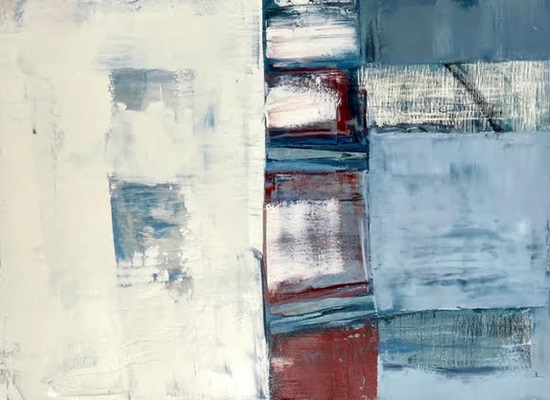
Dinah Case
Hi Dinah, congratulations on becoming one of the twelve winning artists of The Cambridge Invitational! Abstract art often invites viewers to interpret and engage with the work in their own way. Can you discuss your approach to creating abstract paintings and prints, and how you balance intentionality with spontaneity in your process?
Firstly, experimenting on paper, hot pressed smooth, Cass Art’s jumbo or Fabriano’s Artisico, it’s hard wearing, great for mark making and layering acrylic paint, I use the Catalyst wedge and Goldens fluid range, this is how my pieces start. I work spontaneously, I’m reacting to the work as I do it. I see the surface as a puzzle I’m trying to resolve. Colours are led by seasons. I’m drawn to certain shapes and marks. It is at the end of a piece, having sat with it, I feel I will intentionally add or remove to bring the work to a close.
Printmaking offers a unique set of challenges and possibilities compared to other mediums. How does your process differ when creating prints versus paintings, and what attracts you to both forms of expression?
The process is more methodical; with painting I just go for it and work back. Printing I think then do. I have my 300gm Somerset paper ready, ink colours mixed and ready to apply to plates or screens. Mono printing I use like a sketchbook, investigating the changes the printing process brings. Chance things happen and marks can change with every roll of the press or pull of the squeegee, this is exciting! The finish of the printed surface is like no other. I also love the indent from the plate, the definite edge.
Are there particular themes, emotions, or concepts that consistently inspire your work, and how do you translate these into abstract compositions?
I call my pieces abstract landscapes; my environment is the starting point, the resolving of the painting puzzle, the end. I live on the Thames Estuary with its diverse wildlife and industry, I try to convey my passion for this diversity in my work. I use colours influenced by seasonal changes, textures, and shapes found in the landscape to bring a sense of place. The dominant presence of the Thames Estuary is portrayed in the horizontal shapes & horizon lines. I have marks and shapes I use to capture wildlife, weather, structures and feelings, the environment is suggested rather than overt.
Can you share any experiences of collaborating with other artists or printmakers, and how these collaborations have influenced your artistic practice or pushed the boundaries of your work?
One project with The -5 collective photographers group, I was working with a community of shop keepers. What I liked most was thinking outside of my usual practice, mixing the realism of the photographic images with my abstract tropes, deciding how best to merge them and then how to successfully create the pieces in different mediums. I would like to do a collaboration with the RSPB, I made some pieces last year called ‘Where have all the birds gone’ I’d love to make an installation around the theme of bird migration and habitat loss.
Thanks Dinah
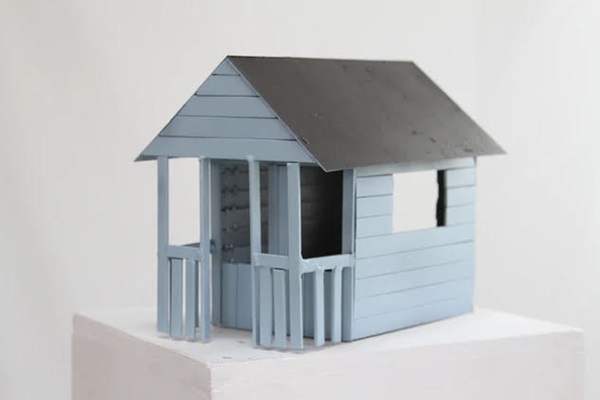
Elizabeth Cooke
Hi Elizabeth, congratulations on being selected as one of the twelve winning artists of The Cambridge Invitational! Steel is a unique material for sculpture, known for its strength and industrial aesthetic. What drew you to working primarily with steel, and how does its properties influence your artistic choices and creative process?
My approach to art is considered but not precise. I started working in stone - that required precision and I felt frustrated that the end result did not look as I would want it. Around the time of learning stone carving I also found a day course in Steel sculpture at Morley college. On day one I was welding and amazed at how quickly I was able to construct something. With the aid of power-tools I could get a result quickly and, just as quickly, change it and try something different. Steel feels very immediate to me. I get my supplies from donations, Suffolk Steel and FH Brundle.
Sculpting with steel often requires specialised tools and techniques. Can you describe your process from conceptualisation to realisation when creating a steel sculpture, including any challenges you encounter and how you overcome them?
Sometimes they are influenced by demand (a lot of birds and animals) and sometimes by something I am intrigued by and can’t stop returning to (sheds and chess pieces). I will take photos, make sketches and do research into the subject. Then I will either create a final drawing or start building the structure ‘freehand’. It is easy to grind off any welding and adjustments can be made very easily. It’s like drawing and rubbing out in 3d. I like to ‘draw with steel’. I can see how the piece is working in three dimensions and adjust accordingly. I couldn’t live without my SGS Mig welder or my Bosch angle grinders, plus a shout out for my new toy (sorry - Tool!) a Sungold plasma cutter.
Steel sculptures can range from abstract forms to intricate figurative works. Can you tell us about your award winning shed series?
I guess I am somewhere in between. Given enough time to work on a subject I like to start with making quite a figurative representation of my subject and then abstract it. I have been observing the fisherman’s sheds in Dunwich, Suffolk for many years. I have a scrapbook of photos documenting how they have changed over time. A lot of time is just spent looking and questioning why I am interested and how I can express my interest. In the last couple of years I realised that the sheds were not slowly deteriorating but were being patched up to be kept in working order. This gave me the idea to use my scraps of metal to create a series of sheds. They are not precise and perfectly made - they reflect the originals, fit for purpose, made of available materials that will keep the sheds functional.
Can you share any experiences of collaborating with metalworkers or fabricators, and how these collaborations have enriched your artistic practice or expanded the possibilities of your steel sculptures?
I tend to shy away from collaborations - the thing I love about sculpture is that I can be solitary and in my own space mentally and physically. Because my work is fluid and organic I feel that I don’t want to pass any of my work on to others to realise. Having said that, I am currently exploring the possibility of getting a chess set fabricated. I have created a set - another project which has been on my mind for many years - and am exploring the possibility of creating a more regimented set of pieces. At the moment each piece is unique. Maybe a matching set of pawns might look better? But… then you lose the handmade element. It’s a fine line. I am as yet undecided.
Thanks Elizabeth!
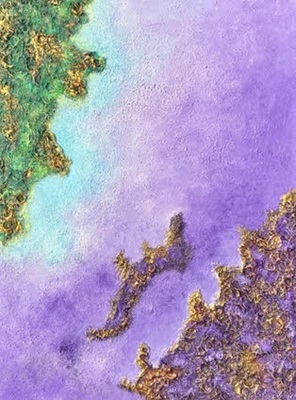
Julia Fernández
Hi Julia, congratulations Julia on being selected as one of the twelve winning artists of The Cambridge Invitational! Your art focuses on environmental themes. Can you share what inspired you to explore environmental issues through your paintings, and how do you hope your work will impact viewers' perceptions of the natural world?
My inspiration to capture nature in my paintings comes from the need to help disseminate the commitment that human beings have to maintain and conserve the natural environment since it is for the development of living beings on Earth.
How do you approach capturing the beauty and fragility of nature in your artwork, and do you incorporate any specific techniques or symbolism to convey environmental messages?
In my paintings I capture nature using natural materials such as earth, gravel or wood, incorporating vibrant colour as an element to highlight to attract the attention of whoever admires them.
Climate change and environmental degradation are pressing global concerns. How does your art reflect these issues, and do you see yourself as an advocate for environmental awareness through your paintings?
Through my works I want to show my commitment to the conservation of forests, seas, animals and of course humans, since only by being aware of climate change and carrying out small daily actions can we do our part. sand in environmental conservation.
Nature is a boundless source of inspiration. Can you discuss how your personal experiences in nature influence your artistic process and the themes you choose to explore in your environmental paintings?
My love for nature means that a simple walk through a field or a beach makes me relax from the hustle and bustle of daily life, admiring the landscapes throughout my travels. For this reason, I transfer this positive energy to my works, being the vehicle to transmit good emotions.
Thanks Julia!
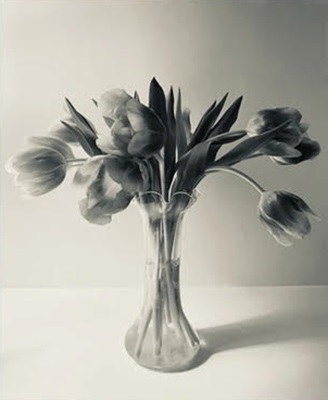
Elizabeth Hay Brown
Hi Elizabeth, congratulations on becoming one of the twelve winning artists of The Cambridge Invitational! As an accomplished photographer, you have developed a distinctive style and approach to your work. Can you describe how your style has evolved over the years and what influences have shaped it?
I used to take photographs of things I liked for no reason other than documenting the scene or object. I now photograph in a series towards a theme or project and often work collaboratively. As digital photography has developed so has my way of working. I can immediately see what I have captured and share the results with my collaborators. Using film you had to wait to see the results. An MA with Paul Hill, a course led by the late Brian Griffin and a residency in Space 36 with Ahmed Farooqui and five other artists have had a huge influence.
Can you share a particularly memorable experience or project where you felt your photography had a profound impact, either on yourself or your audience?
I live on a long street of terraced Edwardian houses, during ‘lockdown’ I photographed 60 households on their doorsteps contacting them all through the street WhatsApp. I would photograph them using my digital camera and on my iPhone. I would immediately Airdrop the images to their phones so they could share them with friends and families and the Street WhatsApp. A designer on the street and I made a banner which we hung in the local grocers. We built a community and made new friends. It was totally uplifting, the community feeling still exists.
Technology has significantly evolved in the field of photography. How do you stay current with emerging trends and advancements, and how do you balance traditional techniques with modern technology in your practice?
I enjoy learning new skills. I am an active member of London Independent Photography and Crouch End Open Studios and attend and organise workshops and talks focusing on the work of photographic artists. Keeping up to date I have an active Instagram account and follow exciting artists and learn about new technology. I attend exhibitions and art events such as Photo London. I experiment in my garden using old technology and sustainable products which I have learnt about on social media and through Cass Art’s blog. I buy Jacquard cyanotype sensitiser to coat art papers. To create Cyanotypes of my plants like Anna Atkins.
Composition plays a crucial role in photography. Could you discuss your thought process behind composing a compelling image, including how you consider factors such as lighting, framing, and subject placement?
Taking the ‘vase of tulips’ as an example. I chose a background, the vase, and the type of lighting which would suit it, then created the set and put my camera to my eye and moved around, up and down to capture the perfect image. I then I painted it with my chosen light sources, took a couple of shots and evaluated. I think of composition as my personal choice wanting to make a subject dynamic but suiting the context. A key factor is the presentation of the work I use a professional printer and framer which makes my work stand out.
Thanks Elizabeth!
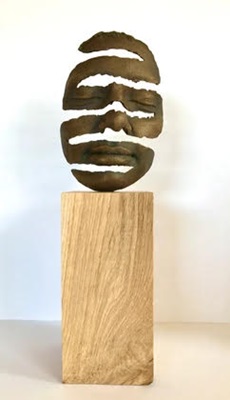
Susan Law
Hi Sue, congratulations on becoming one of the twelve winning artists of The Cambridge Invitational! What attracted you to working with bronze as a sculptural medium, and how does its unique properties influence your artistic choices and creative process?
I love the process of making bronze – making work in the same way that artists have worked for thousands of years! Bronze allows an artist to choose to work in fine detail with delicate elements to the work that are not possible in other mediums. I have a fascination with process and the road that a new artwork takes towards completion.
Could you describe the journey from conceptualizing a sculpture to its final realization in bronze? What are some of the key steps and considerations involved in this process?
My bronze face pieces begin with a photograph of the model. Next, I cast the subject’s face using Life Form silicone rubber from Mouldlife. This mould is coated with Lexicon Select plaster bandage before being removed from the model. I work with hot wax directly into the silicone mould – often I return my work to the wax pot to be remelted and begin again, repeating the process until I am happy with the result. I work closely with the foundry and finish the pieces there before mounting them on oak plinths in my studio.
Bronze sculpting often involves intricate techniques and collaboration with foundries. Can you share some insights into your collaboration process with foundries and how it contributes to the final outcome of your sculptures?
I work closely with the foundry, an independent small business. I do as much of the process as I can in my studio before taking the work to the foundry where it is coated in a ceramic shell and the wax is melted out before the bronze is poured. After the excess metal has been removed I work at the foundry finishing the work, smoothing rough edges and achieving the final form before it is patinated. Doing this final stage myself gives me control of how the finished piece will look.
What themes or messages do you aim to communicate through your work, and how do you use bronze as a medium to convey them effectively?
These bronze sculptures feature a zig-zag of metal, showing only part of the model's face. I want the viewers to look at the work – filling in the voids in the metal in their minds. The strips of metal show fine details of the faces and allow the viewer to mentally complete the form. Negative space, Absence and Presence are recurring themes in my work.
Thanks Sue!
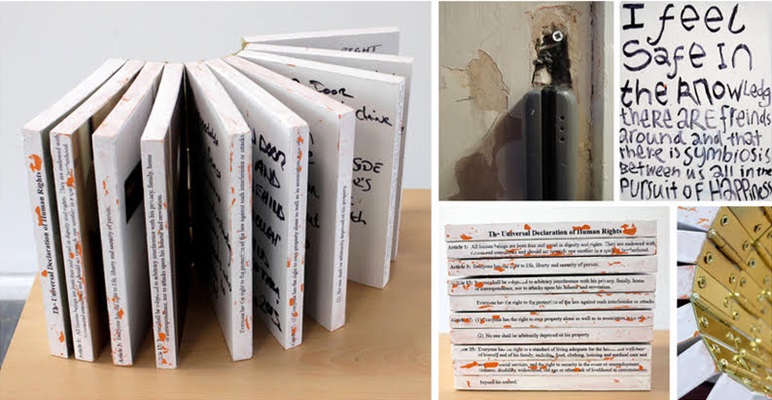
Emma Mayoux-Andrews
Hi Emma, congratulations on being selected as one of the twelve winning artists of The Cambridge Invitational! Can you describe how your multimedia art intersects with the theme of homelessness, and what inspired you to focus your creative efforts in this area?
After returning to my hometown to visit friends living in hostels, I felt compelled to provide a platform for them to safely share an insight into their experiences and pull apart the hostile rhetoric about homeless people. I wanted to put my influences from participatory artists such as Gilian Wearing and Diana Bell to work, so my friends could show for themselves how vibrant, funny, and strong they are – and how hard it can be behind closed doors.
How do you approach representing the experiences and stories of individuals affected by homelessness in your art, and what challenges do you encounter in conveying these narratives through multimedia mediums?
Making art with whatever comes to hand is partly out of financial necessity, but it gives the freedom to follow the concept. Making a ‘book of doors’ felt like the right platform to discuss homelessness - books are made to be interacted with, to be felt, rather than only observed. However, as a ‘jack of all trades’, I deeply felt the responsibility of the technical quality not distracting from the impact of their voices.
In what ways do you believe your art can raise awareness and provoke discussion about homelessness in society, and what outcomes or responses do you hope to evoke from your audience?
The artwork has been useful as the focal point and framework for a workshop discussing ideas for improving support for young homeless people. The workshop included local political representatives, service providers, and people directly or indirectly affected by homelessness. I’m currently writing up their responses into a report to share more widely, particularly with key decision-makers, to hopefully translate ideas into action.
Can you discuss any collaborations or engagements with organizations, communities, or individuals directly impacted by homelessness that have influenced your artistic process or the content of your work?
Having a personal connection with the people made it particularly important for them to directly collaborate on the work. It was a difficult balance, making the most of the privilege of their trust to help others connect with them, while also protecting their privacy. Safety has always been paramount - one is under a domestic abuse protection order, and two have since passed away in very difficult circumstances. These considerations led to choosing handwriting as a medium – we generally only recognise the handwriting of those closest to us, so it’s deeply personal yet anonymous, and uniquely human.
Thanks Emma!
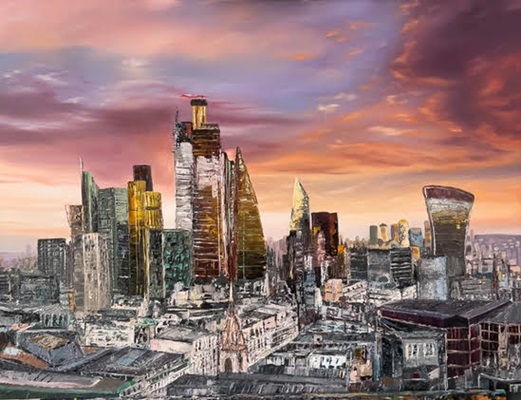
Simona Ivanova Nedeva
Hi Simona, congratulations on becoming one of the twelve winning artists of The Cambridge Invitational! Can you discuss how you choose your subjects and what draws you to particular landscapes?
Thank you - I was delighted to be selected for the Cambridge event! Some of my art has been inspired by my travels and the places I've visited. The landscapes of Scotland are among the most common subjects I've depicted. Scotland's nature evokes a sense of nostalgia for the natural world I was raised in. Another location that has captivated me is China's Yellow Mountains. The unusual rock formations there are stunningly beautiful and mysterious, oozing power. I feel magnetically drawn to paint this place, needing to feel connected to a location before portraying it, even if I've never actually been there; it is about the awe it sparks in me. My London cityscapes are also deeply personal and significant. Through painting the city, I wanted to convey my transformative journey of moving to London and how meaningful this has been in my life so far. I aimed to show the tremendous effort that went into constructing the buildings, which are not just towers but works of art that reflect who we are and how we want to live.
Light and atmosphere play significant roles in landscape painting. How do you approach capturing the mood and atmosphere of a scene, and what techniques do you use to convey these elements effectively?
Choosing the right colours for "Where It All Began" and "Touch the Sky", as well as any other landscape painting I create, is essential for establishing the desired mood. Much of my work utilises bright, vibrant hues that evoke a romantic or peaceful feeling and are full of vitality, fascination, and positive outlook. I develop this ambience through my handling of light, tones, and clarity, using less saturated colours and cooler shades in the distance to impart a sense of depth and openness. My goal is to convey these aspects through oil painting, combining the dry brush technique, flat wash, and impasto to apply thick layers of paint. Depending on the desired texture, I may apply thick layers with a palette knife, either allowing each layer to dry before continuing or adding more paint to wet layers.
How do you strive to depict the beauty and diversity of the natural world in your landscape paintings, and what challenges do you face in doing so?
My landscape paintings aim to portray the splendour and variety of the natural world. I seek to do this by cultivating greater openness and attentiveness to my surroundings. I notice how light shifts over the course of a day and how weather and atmospheric conditions can transform the landscape. By training my eye to discern nature's subtleties, I can gain deeper insight into its complexities and convey them through my art.
One challenge I face is finding a focal point in a landscape or perceiving adequate depth when the view is confined. As a landscape painter, I need to see the landscape I wish to depict through my eyes and must identify and choose combinations of elements and vantage points. In the studio setting, I feel constrained, lacking the freedom of outdoor exploration. I dedicate a significant amount of time to searching for the right photographic reference and use Photoshop to edit the image, altering colours, tweaking the composition, often adding a dramatic sky, and intensifying or brightening hues depending on the mood and settings. I then translate this digitally enhanced image into a painting.
Landscape painting has a long tradition in art history. Are there any landscape painters, past or present, who have particularly influenced or inspired your work, and in what ways?
I have drawn inspiration and been impacted by numerous landscape painters, each providing me with something unique. Bob Ross and Paul Kenton's thick, textured brush strokes shaped my own textured landscapes and city views. Lawrence Coulson's vivid colour palettes and romantic arrangements moved me to create my vibrant skies. Additionally, Van Gogh's bold, dramatic brushwork and colour choices have been an inspiration. When working in a realistic style with abundant detail, Michael James Smith and Layne Johnson's true-to-life approaches have also greatly influenced me. Though each artist imparted something distinct, collectively their diverse styles have enriched my artistic vision. A few of the important substances I utilise to attain these artistic effects are oil paints produced by the brands Winsor & Newton, Gamblin, and Art Spectrum.
Thanks Simona!
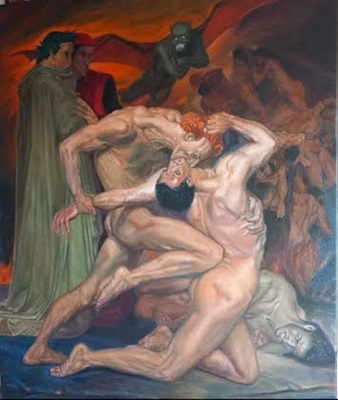
Theofilos Seintis
Hi Theo, congratulations on being selected as one of the twelve winning artists of The Cambridge Invitational! What initially sparked your interest in painting, and how has your artistic journey evolved over time?
I first enjoyed drawing and painting as a child. Then I tried different professions and learned various skills, but, when I was about 25 years old, I tried painting again and it captivated me so much! I felt as if I found what I have always been looking for. Painting has given answers to all my questions and I felt complete as a person. I have been painting ever since and this is more than just a profession for me, painting is my life. I
Every artist has a unique creative process. Can you walk us through your typical process when starting a new painting, from conceptualisation to completion?
I generally have two different types of creative processes. One of them is to research and paint mythological or historical characters and stories associated with them. As I am from Greece, I like to explore the history of my country and to create my own compositions based on mythology. I use the same process when I work on people's portraits or other paintings made to order. On the other hand, I like to begin to paint with just vogue feelings and emotions that I then transfer on the canvas and the final outcome is often far from the initial images that I was imagining. I consider my creative process to be a journey in which I make new revelations and it's very interesting for me to see what the next revelation would be.
Inspiration can come from various sources. What themes, subjects, or experiences do you find yourself repeatedly drawn to in your paintings, and why do they resonate with you?
In my paintings I express my perception of people's souls. For example, I explore how sometimes they voluntarily imprison themselves by following what society imposes on them through social media, television and politicians. So I can say that I take my inspiration from everyday life and from my observation of people. For me the concept of freedom is fundamental and I am exploring it in my paintings. How can you be free in modern day society? I search for answers in my works such as "theatre of insane" and I often turn to Greek philosophers, who gave us so many answers to the most difficult questions, we just need to learn to understand them. I often reflect on the meaning of our short lives. Through my paintings I express my appreciation of being human and being able to experience love, pain, suffering, joy while exploring the amazing enigmatic world we live in. I travel a lot. Seeing new people and cultures gives me new experiences necessary for my inspiration and, of course, I visit a lot of galleries and museums. I really appreciate being able to see the works by great artists of past and present times.
How would you describe your painting style, and how has it developed or changed throughout your career?
I initially learned painting by copying some famous pieces of art, it helped me to develop my skill as an artist. I like developing my skills as it enables me to better express what I want to say through my art. I also like giving freedom to my imagination and I paint the characters and stories that come to my head. I am not trying to make them look realistic, I am just expressing myself, so I believe that my style could be called "magical expressionism". Why is it magical? Because if you don't believe in magic you will never find it.
Thanks Theo!
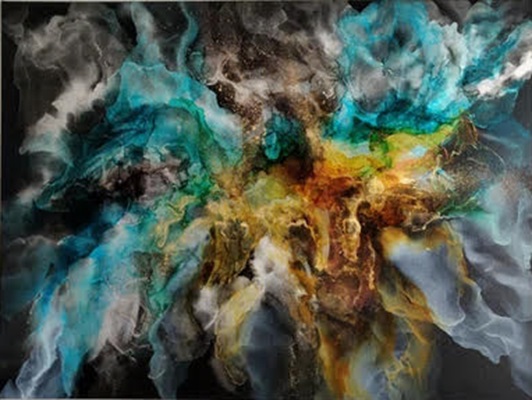
Egle Stabuzyte-Brazdzioniene
Hi Egle, congratulations on becoming one of the twelve winning artists of The Cambridge Invitational! Alcohol ink-based art is known for its vibrant colours and fluid textures. Can you share how you discovered this medium and what drew you to it as an artist?
Alcohol inks are a newly discovered technique for me, which allows me to create and experiment in different ways compared with traditional media. The first time I started to work with alcohol inks was nearly 4 years ago. I learned the techniques from social media and YouTube tutorials etc. It gave me new ideas on how I can express myself as an artist in a wider experimental field. Alcohol-based ink has very high evaporation, which forces me to act very quickly, that is why it leads to new discoveries (sometimes unexpected!) and expanding artistic boundaries.
The unpredictable nature of alcohol-based inks can lead to both surprises and challenges in the creative process. How do you embrace spontaneity while maintaining control over the outcome of your artworks?
The beauty of this technique is that it’s not easy to control, because of the very speedy evaporation, but I think art is not supposed to be controlled. Just as nature is imperfection, you can get the same feeling with alcohol ink media. Every time I’m working with this technique, I never know where the creative process will develop, will stop or expand, lots of surprises are involved in that experiment.
Can you describe some of the techniques or tools you use to achieve specific effects in your artworks?
To dry or capture the ink’s stains I mostly use a heat gun, hairdryer or let it dry naturally. To add more detail to my painting, I apply posca pens, use paint brushes, depending on what needs to be achieved in certain processes. Just recently I began to experiment with gold leaf, which gives an even more vibrant look to my work. For the background of the artworks I mostly use sealed canvases, acrylic or synthetic paper.
What themes or subjects do you often explore in your art, and how do you translate them into your unique visual language?
I believe art should speak without any verbal description. Every viewer should be able to interpret it differently, and that depends on personal life experiences. The majority of my inspiration comes through meditation, and energy flow discoveries. Just diving more deeply into unknown worlds and dimensions, energies, sounds, vibrations, and awareness. All of these are very inspirational for me personally. I feel, that as human beings we are very powerful individuals who are affected and surrounded by still undiscovered energies.
Thanks Egle!
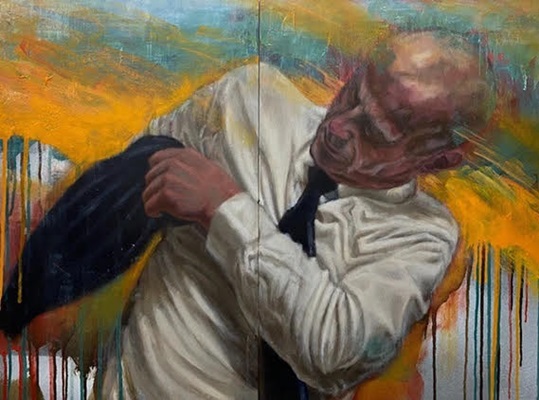
Troy Stuart
Hi Troy, congratulations on being selected as one of the twelve winning artists of The Cambridge Invitational! Your body of work encompasses both portraits and urban environments. How do you navigate between these two subjects creatively and what draws you to each of them as an artist?
I am drawn to portraiture because I love the challenge of trying to capture a likeness of a person in a painting. What drew me to urban art is I lived in London when I first arrived in the UK and was indirectly exposed to a lot of street art and really appreciate how it would provide colour in an otherwise mundane urban scene so I go through phases of trying to incorporate these different styles in my painting to produce something that is hopefully a bit different.
Can you describe your process for portraying individuals in your paintings, including how you convey their unique traits and emotions through your artistic style?
I usually paint from images as it is much more convenient for me, and you can catch a moment in time where the subject is just being themselves and it can be a bit less contrived than painting from life. I am a slow painter, more due to time restraints and I paint in short bursts so by default I build up layers over time. I usually paint with oils ‘Winton’ by Winsor & Newton or Michael Harding and lately I have been glazing more using oil painting medium PM1 by Michael Harding.
Thanks Troy!
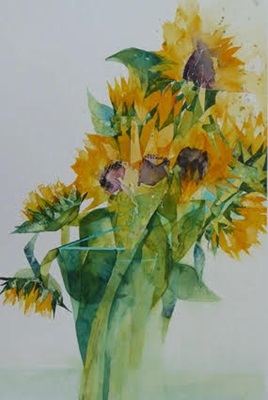
Carol Whitehouse
Hi Carol, congratulations on becoming one of the twelve winning artists of The Cambridge Invitational! What initially drew you to watercolour as your preferred medium, and how has your relationship with it evolved over time?
I was initially drawn to watercolour because of the wonderful effects it can create within a painting. I love the unexpected when two colours collide, or seeing how the water pushes the paint around on the paper to create wonderful shapes and edges. However, what looks easy on paper is never quite what it seems! It took me time and practice to be able to control the watercolour to give me the freshness and brightness I was so keen to achieve in my paintings. By taking time to experiment with watercolour painting I discovered there is no end to its versatility, and the effects it can achieve.
Can you walk us through your creative process when starting a new watercolour piece, from conceptualisation to completion?
My flower paintings start with a very rough sketch for composition. My materials are Fabriano Artistico HP Extra White paper (always stretched on a board), Mijello and Daniel Smith watercolour paints and Rosemary & Co triangular series 40 brushes. I always have the flowers in front of me for reference, but I am not trying to paint an exact image. My paper is prepared with fine random lines of masking fluid. I rarely draw my images before putting down the first marks because I like my paintings to evolve on the paper. I never wet the paper first but add water to the paint as I apply it. My paintings are all about shape and marks, so I am always looking for an abstract element within my paintings which are usually completed in about 4 layers. The first being quite loose and watery and, once dry, I will use the shapes on the paper to start to build up the flowers. By the third and fourth layers I am adding the darks using the shapes within the painting. The final part of my painting is to remove the masking fluid and to add small marks or lines and splatter to add interest to the finished painting.
Watercolour painting often involves embracing unpredictability and working with the fluidity of the medium. How do you navigate challenges or mistakes during the painting process?
The thing I love most about watercolour is its unpredictability, but many a painting has been cast aside because things had “got out of control”. I have now learnt to incorporate these mistakes into my paintings. If I feel I am losing control I will spray the area to dilute the paint and let it run off the paper. By letting the area dry I will see what shapes and effects it has given me. Often wonderful shapes will emerge which when painted over add interest within the painting. I like to use strong dark colours within my work and again, this can be applied to those areas that I want to change the shape of, or cover a colour, that I feel is wrong for the painting.
What themes or subjects do you find yourself repeatedly drawn to in your watercolour work, and why do they resonate with you?
I have always been drawn to paint flowers. I love bold colours and interesting shapes and flowers offer me everything I am looking for in my art. The wonderful colourful heads, the varied shapes of the leaves to the straight and curved stems. Rigid and upright, curved and flowing – flowers offer it all. Whether I am painting big bold peonies or dandelions from the hedgerow, I love the challenge of taking a white piece of paper and creating shapes, lines and marks to interpret the flowers in my own style. There is also a wonderful emotional element to painting flowers as they symbolise so much in our lives.
Thanks Carol!
Feeling inspired?
For further insights into the artists and upcoming competitions, explore the Galeria Moderna website Hub at galeria-moderna.com



